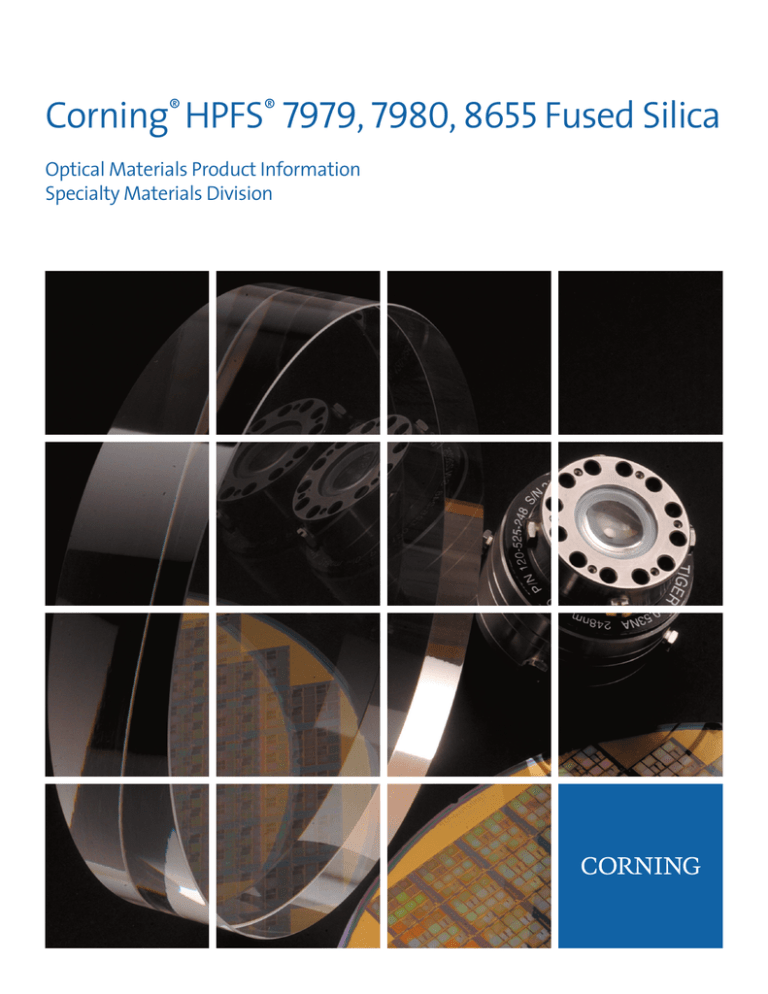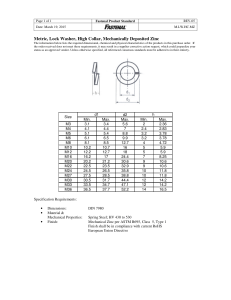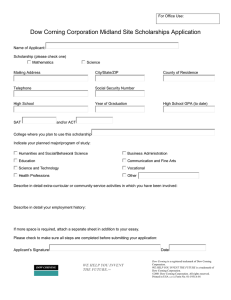
Corning® HPFS® 7979, 7980, 8655 Fused Silica
Optical Materials Product Information
Specialty Materials Division
HPFS® 7979, 7980 and 8655 Fused Silica
HPFS® Summary of Key Attributes
7980 Standard Grade
7980 KrF Grade
7980 ArF Grade
7980 Mirror Grade
7980 Industrial Grade
7979 IR Grade
8655 ArF Grade
Fused Silica
HPFS® Fused Silica glasses are known throughout the
industry for their consistent, repeatable performance.
We offer many different grades of fused silica to support
various product applications. Glass codes 7979, 7980,
and 8655 are high purity non-crystalline silica glasses
with excellent optical qualities. Product characteristics
include extraordinarily low refractive index variations
leading to state-of-the-art homogeneity values, low
birefringence values, large size capabilities, exceptional
transmittance from the deep ultraviolet through the
infrared region, and an ultra-low thermal expansion
coefficient; all of which are critical to our customers’
demanding needs.
Visible Transmittance
■
■
■
■
■
■
■
UV Transmittance
■
■
■
Attribute
■
Infrared Transmittance
HPFS® Laser Resistance
Our strength is in material chemistry and development,
and we are committed to be a technology leader by
continuing our development of new materials. Optical
materials are at the heart of the semiconductor industry.
Microlithography projects a pattern from a photomask
through an optical system to create IC chips using
ultraviolet laser light. Optical inspection microscopes
provide test capabilities for both masks and wafers at
several different stages of the printing process. With the
drive to smaller and smaller structures, the semiconductor
industry continues its quest for better and better optical
systems, and this in turn drives the requirements for the
optical materials.
■
■
■
■
Homogeneity Certified in Use-Axis
AA, A, C, F (By Size)
■
■
■
Inclusion Class Certified
0, 1, 2, 5
■
■
■
■
■
■
Striae Certified
ISO 10110-4 Class 5 (None)
■
■
■
■
■
■
Homogeneity Certified in Off-Axis
AA, A, C, F (By Size)
■
■
■
■
■
Low Birefringence
■
■
■
■
■
■
■
UV Laser Resistant
(Data available upon request)
■
■
Economical
(No certification of any properties
except visible transmission. Tooling
applications.)
■
Quality Grade Selection Chart
For Mirror Grade - see chart on next page
Homogeneity 3,4 [ppm]
Inclusion Class
Grade
Class
Total Inclusion
Cross Section1 [mm2]
Maximum
Size2 [mm]
AA
≤ 0.5
A
≤1
B
≤ 1.5
C
≤2
D
≤3
E
≤4
F
≤5
G
NS5
0
≤0.03
0.10
■
■
■
■
■
■
■
■
■
■
■
■
■
■
■
■
■
■
■
■
■
1
≤0.10
0.28
2
≤0.25
0.50
3
≤0.50
0.76
■
■
■
■
■
4
≤1.00
1.00
■
■
■
■
■
5
≤2.00
1.27
■
■
■
■
■
1. Defines the sum of the cross section in mm of inclusions per 100 cm of glass. Inclusions with a diameter ≤ 0.10 mm are disregarded.
2. Refers to the diameter of the largest single inclusion.
3. Index homogeneity: the maximum index variation (relative), measured over the clear aperture of the blank.
4. Index homogeneity is certified using an interferometer at 632.8 nm. The numerical homogeneity is reported as the average through the
piece thickness. Blanks with a diameter up to 450 mm can be analyzed over the full aperture. Larger parts can be analyzed using multiple
overlapping apertures. The minimum thickness for index homogeneity verification is 20 mm. For thinner parts, the parent piece is certified.
5. NS (Not Specified)
2
3
2
HPFS® Data and Properties
Inclusion Class
Birefringence
[nm/cm]
Striae
ISO 10110-4
Class
Metallic
Impurities
[ppb]
OH Content
[ppm]
Homogeneity
Grade
available upon request
Lower specifications
7979 IR Grade
0, 1, 2
AA, A, C, F
≤5
5
< 100
<1
7980 Standard Grade**
0-5
AA - F
≤5
5
< 1000
800 - 1000
7980 KrF Grade*
0, 1, 2
AA, A, C, F
≤1
5
< 500
800 - 1000
7980 ArF Grade*
0, 1, 2
AA, A, C, F
≤1
5
< 100
800 - 1000
See below
NS
≤5
1
NS
800 - 1000
NS
NS
≤5
1
NS
800 - 1000
0, 1, 2
AA, A, C, F
≤1
5
< 10
<1
7980 Mirror Grade
7980 Industrial Grade
8655 ArF Grade*
* No visible fluorescence when exposed to deuterium source from 215 nm - 400 nm. Material contains hydrogen to minimize absorption
under UV exposures.
** HPFS® 7980 Standard Fluorescence-free Grade available upon request.
Mechanical Properties
Thermal Properties
Unless otherwise stated, all values @ 25 °C
Glass Code:
7980
7979
8655
Elastic (Young’s) Modulus
73 GPa
Shear Modulus
Modulus of Rupture, abraded
Softening Point*
1585 ˚C
1627 ˚C
1627 ˚C
107.6 poises
31 GPa
Annealing Point*
1042 ˚C
1180 ˚C
1180 ˚C
1013 poises
52.4 MPa
Strain Point*
893 ˚C
1068 ˚C
1068 ˚C
1014.5 poises
Bulk Modulus
35.9 GPa
Specific Heat0.770 J/(g K)
Poisson’s Ratio
0.16
Density
2.20 g/cm3
Thermal Conductivity
Knoop Hardness (100g load)
522 kg/mm2
Tensile Strength
54 MPa
Compressive Strength
1.14 GPa
Thermal Expansion** (ppm/C):
Mirror Quality Grade Selection Chart
Mirror Grade: Inclusion Classes
Max. Mean
Diameter
Max. Avg. #/mm3
(#/in3)
Non-Critical Zone:
Max. Mean
Diameter
Max. Avg. #/mm3
(#/in3)
1.38 W/(m K)
Thermal Diffusivity0.0075 cm2/s
5 ˚C to 35 ˚C
0.52 x 10-6
0 ˚C to 200 ˚C
0.57 x 10-6
-100 ˚C to +200 ˚C
0.48 x 10-6
ASTM Procedures - *C-598, **E-228
Critical Zone:
Viscosity
Blank Dimensions (Diameter or Diagonal)
< 508 mm
(20”)
508 - 1143 mm
(20 - 45”)
1143 - 2286 mm
(45 - 90”)
0.254 mm
(0.010”)
0.762 mm
(0.030”)
1.524 mm
(0.060”)
2 ppm
(0.04)
3 ppm
(0.05)
5 ppm
(0.08)
Blank Dimensions (Diameter or Diagonal)
< 508 mm
(20”)
508 - 1143 mm
(20 - 45”)
1143 - 2286 mm
(45 - 90”)
1.016 mm
(0.040”)
1.524 mm
(0.060”)
3.81 mm
(0.150”)
3 ppm
(0.05)
3 ppm
(0.05)
9 ppm
(0.15)
3
Internal Transmittance 7980
100
90
80
Ti [%/cm]
70
60
50
40
30
20
10
0
0
500
1000
1500
2000
2500
3000
3500
4000
4500
5000
Wavelength [nm]
HPFS® 7980 Standard Grade meets high Ti ≥ 88.00 %/cm @185 nm. (Equivalent to Te ≥ 80.00 %/cm @185 nm)
HPFS® 7980 KrF Grade meets high Ti ≥ 99.90 %/cm @248 nm.
HPFS® 7980 ArF Grade meets high Ti ≥ 99.50 %/cm @193 nm.
Higher transmittance is available upon request.
Internal Transmittance 7979
100
90
80
Ti [%/cm]
70
60
50
40
30
20
10
0
0
500
1000
1500
2000
2500
Wavelength [nm]
4
3000
3500
4000
4500
5000
Internal Transmittance 8655
100.0
Ti [%/cm]
99.8
99.6
99.4
99.0
170
175
180
185
190
195
200
205
210
215
220
225
230
235
240
245
250
255
260
265
270
275
280
285
290
295
300
305
310
315
320
325
330
335
340
345
350
355
360
365
370
375
380
385
390
395
400
99.2
Wavelength [nm]
HPFS® 8655 Grade meets high Ti ≥ 99.75 %/cm @193 nm.
Higher transmittance is available upon request.
Typical initial absorption k: ≤ 0.0005 ppm/cm at 193 nm.
5
Refractive Index and Dispersion: HPFS® 7980
Conditions: 22 ˚C, 760 mm Hg, N2
Wavelength
[Vacuum]
[nm]
Refractive
Index2
n
Thermal
Coefficient
∆n/∆T3
[ppm/C]
1128.950
1.448866
9.6
A0
2.104025406E+00
1014.260 nt
1.450241
9.6
A1
-1.456000330E-04
852.344 ns
1.452463
9.7
A2
-9.049135390E-03
706.714 nr
1.455144
9.9
A3
8.801830992E-03
656.454 nC
1.456364
9.9
A4
8.435237228E-05
Polynomial Dispersion Equation Constants1, 22 ˚C
632.990
1.457016
10.0
A5
1.681656789E-06
587.725 nd
1.458461
10.1
A6
-1.675425449E-08
546.227 ne
1.460076
10.2
A7
8.326602461E-10
486.269 nF
1.463123
10.4
435.957 ng
1.466691
10.6
404.770 nh
1.469615
10.8
A1
0.68374049400
365.119 ni
1.474539
11.2
A2
0.42032361300
334.244
1.479764
11.6
A3
0.58502748000
312.657
1.484493
12.0
Sellmeier Dispersion Equation Constants2, 22 ˚C
253.728
1.505522
13.9
B1
0.00460352869
228.872
1.521154
15.5
B2
0.01339688560
214.506
1.533722
17.0
B3
64.49327320000
206.266
1.542665
18.1
194.227
1.558918
20.3
184.950
1.575017
22.7
∆n/∆T Dispersion Equation Constants3, 20-25 ˚C
C0
9.390590
C1
0.235290
C2
-1.318560E-03
C3
3.028870E-04
Other Optical Properties
nF'-nC'
0.006797
Stress Coefficient
35.0 nm/cm MPa
Abbe Constants:
Ve
67.6
Vd
67.8
*1 Polynomial Equation: n2 = A0 + A1 λ4 + A2 λ2 + A3 λ-2 + A4 λ-4 + A5 λ-6 + A6 λ-8 + A7 λ-10 with λ in μm
*2 Sellmeier Equation: n2-1 = A1λ2/( λ2 - B1) + A2 λ2/( λ2 – B2) + A3 λ2/( λ2 – B3) with λ in μm
*3 ∆n/∆T Equation: ∆n/∆T [ppm/C] = C0 + C1λ-2 + C2λ-4 + C3λ-6 with λ in μm
The above dispersion equations for SiO2 were fit to the refractive indices of 20 wavelengths from 1129 nm to 185 nm.
6
Refractive Index and Dispersion: HPFS® 8655 and 7979
Conditions: 22 ˚C, 760 mm Hg, N2
Wavelength
[Vacuum]
[nm]
Refractive Index1
n
Thermal
Coefficient2
∆n/∆T [ppm/C]
2326.050
1.433027
8.7
A1
7.033574317E-02
2058.650
1.437307
9.3
A2
7.241205497E-01
1970.630
1.438601
9.6
A3
3.097807778E-01
1813.570
1.440776
9.1
A4
9.309957497E-01
1530.000
1.444337
9.7
B1
-2.301552288E-03
1128.950
1.448930
9.7
B2
6.272886117E-03
1014.26 nt
1.450304
9.6
B3
1.415449740E-02
852.344 ns
1.452526
9.5
B4
1.016434845E+02
Sellmeier Dispersion Equation Constants1, 20 ˚C
780.237
1.453731
9.5
706.714 nr
1.455205
9.9
656.454 nC
1.456425
10.1
A1
3.550277875E-02
644.025 nC'
1.456763
10.1
A2
7.353314507E-01
Sellmeier Dispersion Equation Constants1, 22 ˚C
632.990
1.457077
9.9
A3
3.334560303E-01
587.725 nd
1.458522
10.2
A4
9.269506614E-01
546.227 ne
1.460135
10.5
B1
-4.826183477E-03
486.269 nF
1.463183
10.4
B2
5.808687673E-03
480.126 nF'
1.463561
10.4
B3
1.399572492E-02
435.957 ng
1.466751
10.7
B4
1.012182926E+02
404.770 nh
1.469674
10.9
388.975
1.471446
10.9
365.119 ni
1.474599
11.3
A1
2.623483282E-02
340.463
1.478646
11.6
A2
7.306029048E-01
334.244
1.479824
11.7
A3
3.475321572E-01
312.657
1.484554
12.0
A4
9.216052441E-01
Sellmeier Dispersion Equation Constants1, 25 ˚C
296.814
1.488798
12.5
B1
-5.783959035E-03
289.444
1.491056
12.5
B2
5.600103210E-03
253.728
1.505585
14.0
B3
1.389808930E-02
228.872
1.521218
15.3
B4
1.006578079E+02
226.572
1.523018
15.9
214.506
1.533786
16.8
213.923
1.534371
17.0
D0
9.545124E+00
-9.835579E-02
2.003170E-01
∆n/∆T Dispersion Equation Constants2, 20-25 ˚C
206.266
1.542731
18.2
D1
202.613
1.547213
18.3
D2
194.227
1.558985
20.4
D3
2.209816E-03
184.950
1.575091
22.1
D4
1.980644E-04
Other Optical Properties
nF'-nC'
0.006797
Stress Coefficient
35.0 nm/cm MPa
Abbe Constants:
Ve
67.6
Vd
67.8
*1 Sellmeier Equation: n2-1 = A1 λ2/( λ2 - B1) + A2 λ2/( λ2 – B2) + A3 λ2/( λ2 – B3) + A4 λ2/( λ2 – B4) with λ in μm
*2 ∆n/∆T Equation: ∆n/∆T [ppm/C] = D0 + D1λ2 + D2λ-2 + D3λ-4 + D4λ-6 with λ in μm
The above Sellmeier dispersion equation for SiO2 was used to fit the refractive indices of 35 wavelengths from 2326 nm
to 185 nm.
7
Worldwide Accessibility
We are here to help you specify the best product for your application. For further information, please contact:
North America Sales Office
Corning Incorporated
Semiconductor Optics Business
334 County Route 16
Canton, NY 13617
t: 315.379.3364
f: 315.379.3344
Asia Sales Offices
Corning International K.K. Japan
Akasaka Intercity, 7th Floor
1-11-44, Akasaka,
Minato-ku, Tokyo 107-0052
Japan
t: 81.3.3586.1052
f: 81.3.3587.0906
Corning Korea Company Ltd.
6th Floor, Gangnam Finance
Center
737 Yeoksam-Dong
Gangnam-Gu
Seoul, Korea 135-984
t: 82.2.796.7500
f: 82.2.796.7300
Europe Sales Office
Corning GmbH
Corning International
Abraham-Lincoln-Strasse 30
D-65189 Wiesbaden
Germany
t: 00800.4.267.64.64 or
49.611.7366.100
f: 00800.5.267.64.64 or
49.611.7366.143
e-mail: Cigermany@corning.com
Corning International
1 Kim Seng Promenade
#12-12
Great World City
West Tower
Singapore 237994
Republic of Singapore
t: 65.733.6511
f: 65.861.7310
Corning Glass Taiwan Co. Ltd.
Room # 1023, 12F
No. 205
Tun Hua North Road
Tiapei, Taiwan
t: 886.2.2716.0338
f: 886.2.2716.0339
China (Shanghai) Sales Office
Corning China (Shanghai)
Regional Headquarters
8F, Wheelock Square
1717 West Nanjing Road
Shanghai
China 200040
t: 86.21.2215.2888
f: 86.21.6215.2988
For additional product or technical information, please visit: www.corning.com | www.corning.com/advanced-optics
To place an order, obtain additional technical information or specific requirements, please contact us at specialtymaterials@corning.com
The information contained herein is based upon data considered to be accurate. However, no warranty is expressed or implied regarding the
performance of this product. The only applicable warranties are those that are set out in a contract or purchase agreements.
© 2014 Corning Incorporated. All Rights Reserved.
Corning and HPFS are registered trademarks of Corning Incorporated, Corning, NY. Corning Incorporated, One Riverfront Plaza, Corning, NY 14831-0001
Corning/Specialty Materials/Product Information Sheet 7979, 7980 and 8655 July, 2014
8





